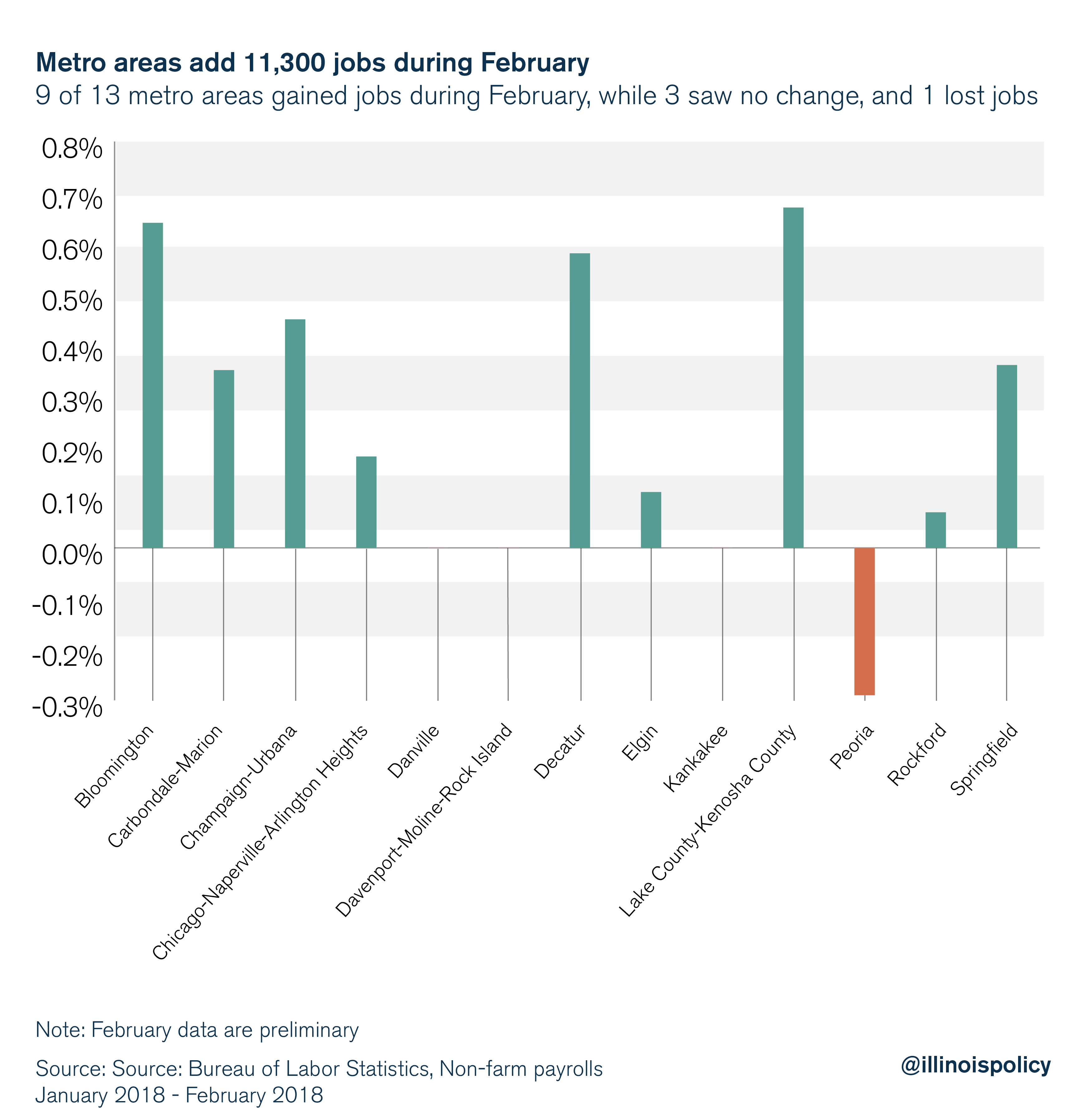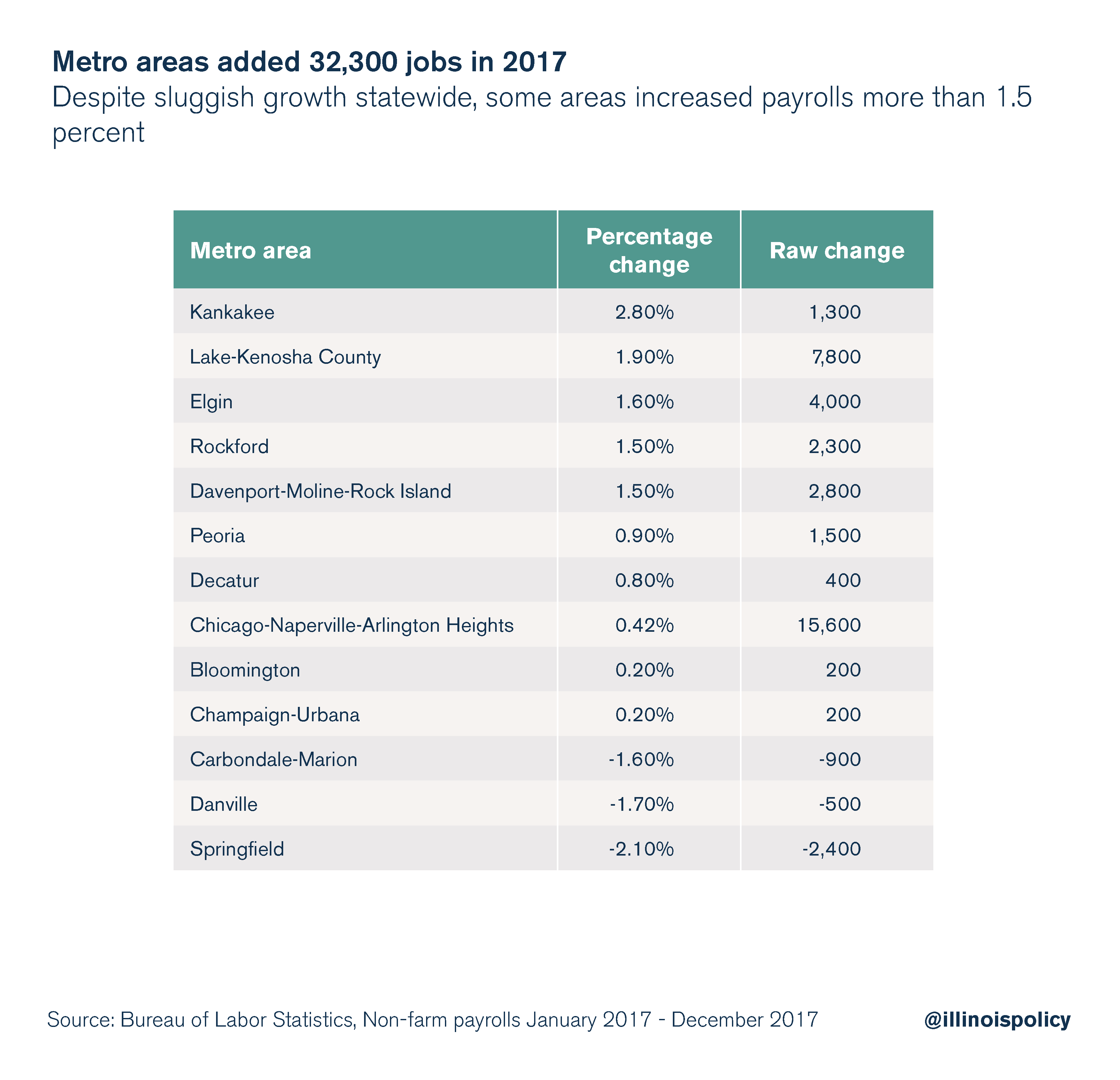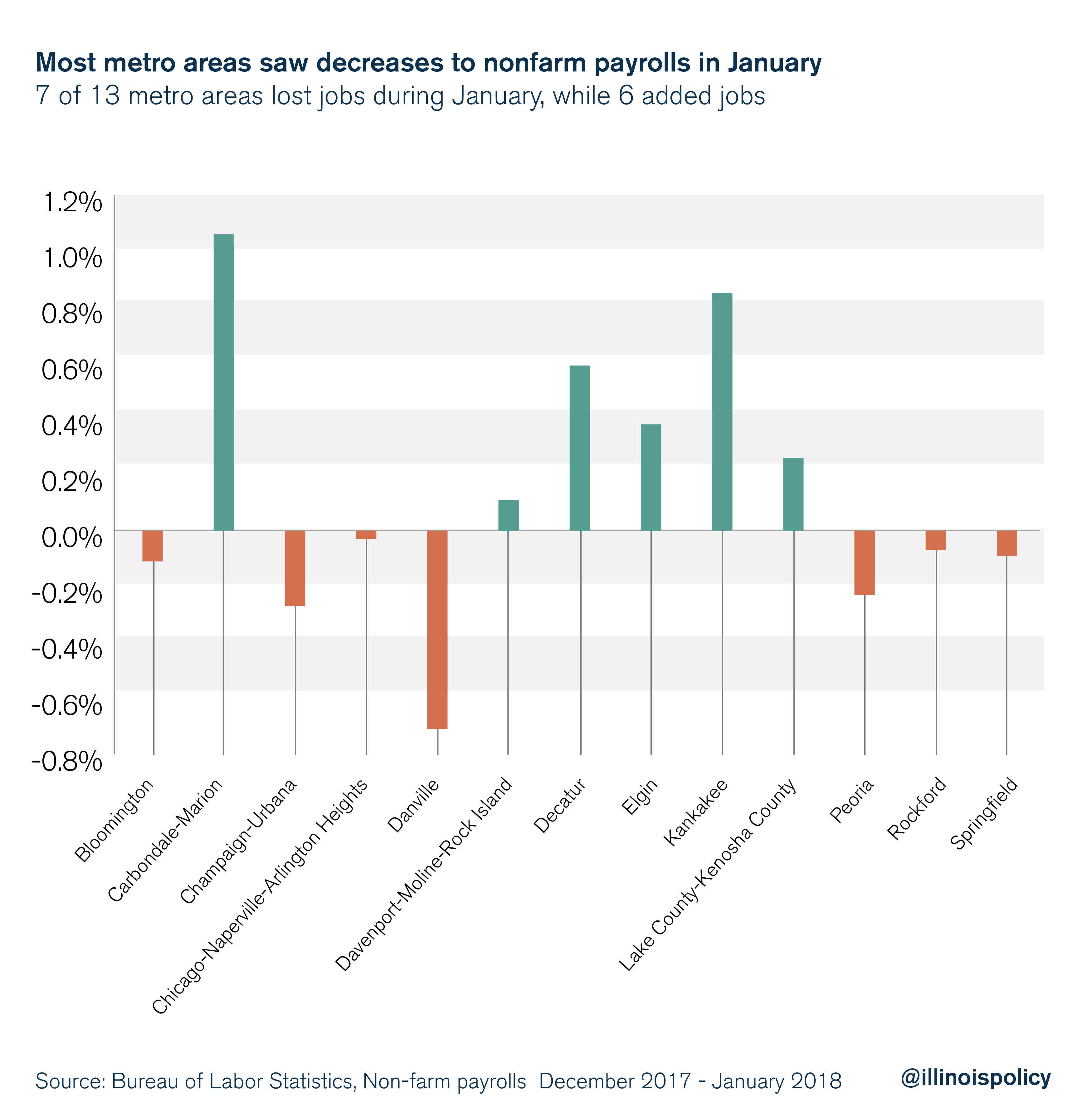3 Illinois metro areas saw jobs decline in 2017, 9 see growth in February
Illinois’ metro areas added 11,300 jobs in February, while only one metro area lost jobs over the month. Despite strong employment growth from metro areas in February, Illinois is still far behind U.S. growth over the last 12 months.
Illinois’ largest metro areas saw modest gains in seasonally adjusted, nonfarm employment payrolls in February, preliminary jobs data reveal. However, three metro areas in the Land of Lincoln did not experience new job creation, while one actually saw a decrease in payrolls.
And unfortunately, revised jobs data show three Illinois metro areas saw over-the-year jobs losses in 2017.
Performance over the month
Jobs data from the Bureau of Labor Statistics, or BLS, released March 29 show Illinois metro areas combined to add 11,300 jobs to nonfarm payrolls over the month of February.
But this is not to say all areas experienced payroll growth.
Areas that gained jobs this month were Lake-Kenosha County, up 0.67 percent (+2,800 jobs); Bloomington, up 0.64 percent (+600 jobs); Decatur, up 0.58 percent (+300 jobs); Champaign-Urbana, up 0.45 percent (+500 jobs); Springfield, up 0.36 percent (+400 jobs); Carbondale-Marion, up 0.35 percent (+200 jobs); Chicago-Naperville-Arlington Heights, up 0.18 percent (+6,600 jobs); Elgin, up 0.11 percent (+300 jobs) and Rockford, up 0.07 percent (+100 jobs).
Areas that saw no change in payrolls were Danville, Davenport-Moline-Rock Island and Kankakee. Meanwhile, Peoria experienced a 0.29 percent decline (-500 jobs) in nonfarm payrolls.

This February is an improvement from metro area performances in February 2017, when only 4,900 jobs were added.
Revisions to 2017 jobs numbers
In addition to the preliminary February numbers released March 29, revisions have also been made to previous months’ data. By now, the BLS has completed all of the revisions for monthly jobs data in 2017. With these new revisions, it is worth revisiting to see how Illinois’ metro areas fared during the year.

The Chicago metro area drove much of the employment growth in terms of sheer numbers, adding 15,600 jobs over the year. However, other areas saw stronger employment growth relative to the size of their labor market. Kankakee payrolls were up 2.8 percent (+1,300 jobs) in 2017; Lake-Kenosha County payrolls grew 1.9 percent (+7,800 jobs); Elgin increased 1.6 percent (+4,000 jobs); Rockford grew 1.5 percent (+2,300 jobs); Davenport-Moline-Rock Island also saw a 1.5 percent increase (+2,800 jobs); Peoria increased 0.9 percent (+1,500 jobs); Decatur payrolls were up 0.8 percent (+400 jobs); Bloomington grew 0.2 percent (+200 jobs) and Champaign-Urbana also grew 0.2 percent (+200 jobs).
Unfortunately, three metro areas experienced a decline in nonfarm payrolls in 2017. Carbondale-Marion payrolls shrunk 1.6 percent (-900 jobs); Danville lost 1.7 percent (-500 jobs) and Springfield lost 2.1 percent (-2,400 jobs).
January 2018 update
January’s jobs numbers were also revised. The updated figures show that more metro areas lost jobs in January than gained jobs.

The areas that fared best were: Carbondale-Marion, up 1.1 percent (+600 jobs); Kankakee, up 0.9 percent (+400 jobs); Decatur, up 0.6 percent (+300 jobs); Elgin, up 0.4 percent (+1,000 jobs); Lake-Kenosha County, up 0.3 percent (+1,100) and Davenport-Moline-Rock Island, up 0.1 percent (+200 jobs).
The remaining Illinois metro areas lost jobs in February. Chicago-Naperville-Arlington Heights payrolls declined 0.03 percent (-1,000 jobs); Rockford, down 0.1 percent (-100 jobs); Springfield, down 0.1 percent (-100 jobs); Bloomington, down 0.1 percent (-100 jobs), Peoria, down 0.2 percent (-400 jobs), Champaign-Urbana, down 0.3 percent (-300 jobs); and Danville, down 0.7 percent (-200 jobs).
What the state needs
This jobs report may provide hope that the Illinois labor market could begin a more robust upward trend it hasn’t seen since the end of the recession – provided that these numbers aren’t revised downward next month. However, in the last 12 months, Illinois nonfarm payrolls have grown at nearly half the growth rate of employment in the rest of the U.S. Slow payroll expansion compared to the rest of the nation makes other states more attractive for families and businesses. This is consistent with Illinois’ persistent outmigration.
Nonfarm payrolls in the rest of the U.S. have grown twice as fast as they have in Illinois.

Many factors could continue to hamper job creation within the state if lawmakers don’t make changes.
Illinois needs to rid itself of the overwhelming tax burden crowding out private investment. A lower tax burden would stimulate investment and job creation.
Illinois’ egregious tax burden has, perhaps, the most detrimental impact on small businesses, which created 75 percent of the net new jobs in 2016. With small businesses contributing so much to the real growth in the state’s labor market, lawmakers should look to make it easier for new entrepreneurs to become successful.
However, the only way to provide relief to small business owners through lower taxes is to rein in government spending both at the local and state levels. Illinois should look to places like Virginia for ways to curb spending without negatively affecting the delivery of core services.

